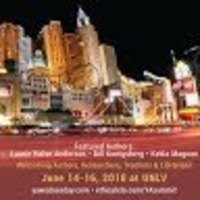Steven T . Bickmore
University of Nevada, Las Vegas, Teaching and Learning, Faculty Member
Research Interests:
Research Interests:
Research Interests:
I am an extremely biased guest editor. I love the books treated within this special issue of First Opinion, Second Reaction, which is a retrospective look backwards at novels that might be part of “classic” young adult literature (YAL).... more
I am an extremely biased guest editor. I love the books treated within this special issue of First Opinion, Second Reaction, which is a retrospective look backwards at novels that might be part of “classic” young adult literature (YAL). Let me explain; I have been teaching in high schools or preparing teacher educators for 35 years. Okay, I am a really old guy; nevertheless, the books reviewed in this issue kept surfacing in my personal and professional life. I see them listed in the syllabi of young adult literature courses, they are in classroom libraries of pre-service and in-service teachers, and, more importantly, they stay in the hands of young readers. Adolescents read these books. I have first opinions and second reactions about all of these books. I encountered The Contender (Lipsyte) in middle school (1968–970). I was assigned both The Outsiders (Hinton) and I am the Cheese (Cormier) in a course associated with my teacher training (1977–979). I found Dinky Hocker Shoots Sm...
Research Interests:
Research Interests:
Research Interests:
Research Interests:
Research Interests:
This study used an organizational socialization lens to examine factors influencing participants’ decision to pursue the principalship and choice to engage in an alternate administration certification program. Through an analysis of... more
This study used an organizational socialization lens to examine factors influencing participants’ decision to pursue the principalship and choice to engage in an alternate administration certification program. Through an analysis of participant focus groups and interviews, factors emerged from the codes that were compared with dimensions of a socialization framework. A key finding is the intersection of socializing factors that influenced participants’ decisions to pursue the principalship and their choice to pursue an alternative preparation program. Two factors that influenced their decision to pursue the principalship, internal processes related to seeing themselves as change agents and their image of the role of the principal as a vehicle for impacting educational outcomes, connected with the innovative organizational/contextual philosophy of the alternate preparation program. This intersection had a major influence in how these aspiring principals came to pursue this alternate ...
Research Interests:
Research Interests:
Urban communities, separated by race and class, experience a disproportionate number of gun deaths, police shootings, crime, violent and nonviolent protests, as well as disparities in housing, education, and employment. These discussions... more
Urban communities, separated by race and class, experience a disproportionate number of gun deaths, police shootings, crime, violent and nonviolent protests, as well as disparities in housing, education, and employment. These discussions are visual and textual, appearing in both traditional and social media outlets. How do adolescents read and make sense of these images? We discuss integrating a Social Studies practice, Visual Discovery Strategy, with Young Adult Literature to provide students with the skills to both critique images from the events in their lives and produce responses through both traditional and digital methods.
Research Interests:
Research Interests:
Research Interests:
progressive ideas offered by John Dewey (e.g., Dewey, 1902) at the turn of the 20th century had an immediate and widespread impact on educational thinking. Applebee (1974) reports that in 1902, Percival Chubb, principal of the High School... more
progressive ideas offered by John Dewey (e.g., Dewey, 1902) at the turn of the 20th century had an immediate and widespread impact on educational thinking. Applebee (1974) reports that in 1902, Percival Chubb, principal of the High School Department of the Ethical Culture Schools in New York City, wrote: "In prescribing literature . . . two requirements must be kept in mind . . . [the] characteristics, the needs, and the interests of the adolescent mind [and] the vocational needs and social demands" made upon the high school curriculum. Applebee argues that Chubb anticipated important developments in the decades ahead: "[I]t would no longer be the student who must adjust to the school, proving his competence to follow the prescribed, academic course, but the school that must adjust to the student, meeting his personal and social needs" (p. 46). Across the ocean the British Handbook of Suggestions for the Consideration of Teachers and Others Concerned in the Work ...
Research Interests:
Research Interests:
Research Interests:
Research Interests:
observers of schools have noted that teachers work within multiple and seemingly contradictory pedagogical traditions. Dixon (1975), for instance, identifies three traditions that influence English teachers' thinking in U. R. schools:... more
observers of schools have noted that teachers work within multiple and seemingly contradictory pedagogical traditions. Dixon (1975), for instance, identifies three traditions that influence English teachers' thinking in U. R. schools: one focused on skills, one centered on knowledge of a cultural heritage, and one dedicated to the personal growth of students (cf. Applebee, 1974, in U. S. schools). Together, the skills and cultural heritage traditions emphasize the acquisition of skills and knowledge, while the personal growth model focuses on developmental learning processes and the well-being of the learner. Barnes (1992) describes two approaches to using language in school, one stressing final draft or formal expression and one emphasizing exploratory thinking, allowing ideas to emerge through talking or writing. Marshall (1993) argues that teachers of literature are simultaneously influenced by two traditions, the New Critical method that emphasizes formal textual meaning and...
